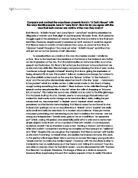Compare and contrast the ways Ibsen presents Nora in A Dolls House with the ways Bront presents Jane in Jane Eyre.
Compare and contrast the ways Ibsen presents Nora in “A Doll’s House” with the ways Brontë presents Jane in “Jane Eyre”. How far do you agree with the view that both women are victims of the men they marry?
Both Nora in “A Doll’s House” and Jane Eyre in “Jane Eyre” could be described as allegories of women and their plight in contemporary Victorian times. Both personas struggle against the restrictions of women during this time and strive to find their own identities. However, despite society’s pressure on both women, it could be argued that Nora is more of a victim of her husband than Jane, as Jane has had time to ‘discover’ herself throughout the novel, yet when “A Doll’s House” ends Nora has only just set out on her ‘journey of self-discovery’.
To describe Nora as a victim of the man she married wouldn’t wholly be untrue. Due to the treatment she received at the hands of her husband and father our first impressions of her are, that she behaves like an immature child, due to her speech and behaviour. On Nora’s first entrance she is shown to be quite immature as she acts very child-like. Nora is happy and joyous mirroring the time of year as she ‘continues to laugh happily to herself’ showing that she is giving the impression of being cheerful. On its own this wouldn’t strike an audience as strange but added to her other childish actions such as the way she ‘tiptoes’ to listen ‘at her husband’s door’ and the way she clandestinely wipes her mouth after she “pops… macaroons in her pocket” which is a similar action a child would make to the threat of being caught eating something they shouldn’t. Nora is shown to be child-like through her speech as she uses phrases like ‘a tiny bit’ when she talks of shopping or “lots and lots of money”. This makes her sound very childish and so adds to the little girl image that has been built up thus far. Torvald, seems to encourage this behaviour as it makes him feel manly and in charge as he treats her like a child, calling her pet names such as, ‘squander-bird” a ‘skylark’ and a ‘squirrel’ which could be perceived as affectionate terms implying that Nora is cared for and loved by her husband but perhaps not on an equal level as a ‘skylark’ and a ‘squirrel’ are really quite small and delicate creatures. To a modern day audience these pet names may seem patronising and demeaning as we tend to believe that women can be strong and independent. Torvald even goes so far as to call Nora “an expensive pet” which, during this period, was essentially partly what a wife was to some men-simply objects to be shown off as a symbol of their own wealth; a contemporary audience wouldn’t be so shocked to see a man treating a woman as if she were a child who couldn’t understand anything too complex as they were just so “delicate” and “little”. Despite this, we are given the impression that Nora is content with her life as she starts ‘humming’ to herself when, she realises her husband is home. This adds to the perfect wife image Ibsen tries to convey as we see this happy young wife who “simply wanted to make [her family] happy”. However, with the way Nora is able to manipulate men so easily because of her beauty and taking into account how she was able to acquire a loan for Torvald in secret, we are also presented with the idea that Nora isn’t so simple. Therefore, the image of Nora as a victim is accurate because Nora is portraying the part that society expects of her. In reality this role is just a facade covering the instability and lies that are barely holding this family together.








